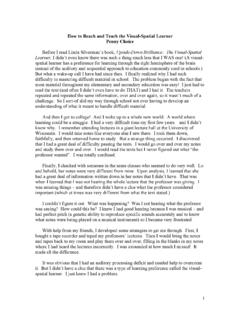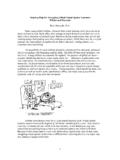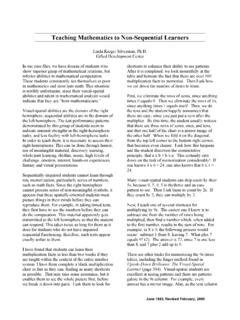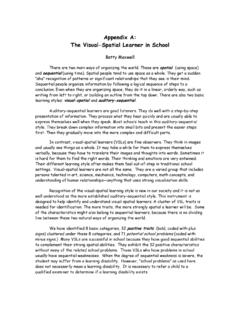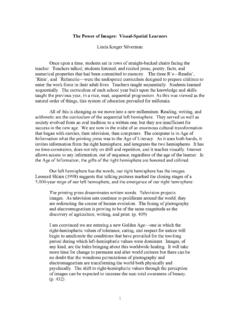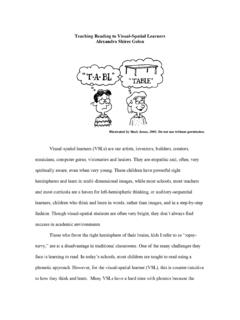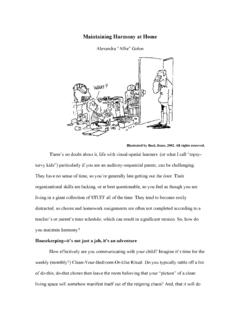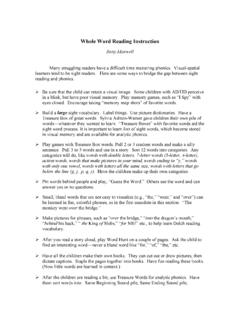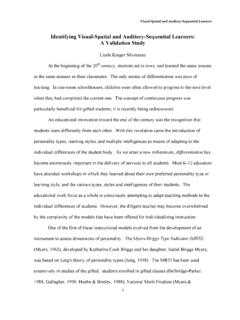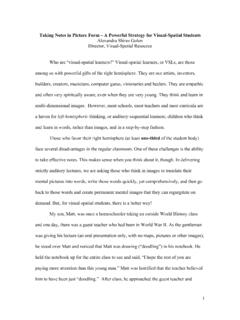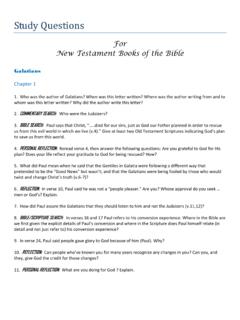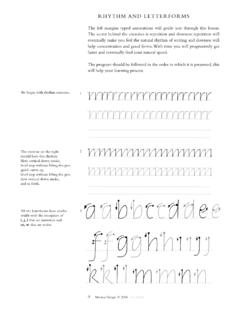Transcription of Poor Handwriting: A Major Cause of …
1 poor handwriting : A Major Cause of underachievement Linda Silverman, handwriting disastrous. His handwriting is unreadable. Her handwriting is so terrible they have created an IEP so she can keyboard.. handwriting was really hard. I type now. I have really messy handwriting , too.. These are typical of the comments we received in response to a list of characteristics of the visual-spatial learner that we posted on our website. Visual-spatial learners think in pictures and need more time to translate their pictures into words. If they have sequential weaknesses, they have difficulty with word retrieval, and struggle with sequential tasks, such as reading, spelling, calculation, writing, and organization. They are 3-dimensional thinkers who can see objects from different perspectives. They excel at puzzles, mazes, map reading, construction, art, science, music, mechanics, computers, problem solving, creativity, and empathy.
2 Their abilities are well-suited to our technological era, and actually enhance employment opportunities in adulthood. However, they are not well-suited to the demands of school. Up until the 21st century, education focused on left hemispheric, sequential skills, and right hemispheric spatial skills were seen as irrelevant. While this is beginning to change, visual-spatial learners still feel stupid in school and are frequently counted among the underachievers. We often attribute underachievement to motivational and psychological factors. We blame the child for being lazy and not trying hard enough. We blame the parents for being poor disciplinarians. However, my research over the last two decades, with over 4,200 gifted children, has led me to the conclusion that the majority of bright underachievers suffer from hidden disabilities. My first observation was that gifted underachievers often had a high incidence of ear infections in the first few years of life.
3 My second observation was that many had had difficult births. Both of these factors impair fine motor planning, which is essential for smooth, rapid, comfortable writing. I. have now investigated several disabilities that can Cause underachievement : sensory- motor integration dysfunction, central auditory processing disorder, visual processing deficits, attention deficit/hyperactivity disorder, and dyslexia. Many of these disabilities affect left hemispheric, sequential processing, and enhance the chances that the child will become a right hemispheric, visual-spatial learner. The remainder of this paper consists of excerpts of my book, Upside-Down Brilliance: The Visual-Spatial Learner, which pertain specifically to difficulties mastering handwriting or handwriting speed. I've included a diagnostic checklist and a list of recommended adaptations. The main accommodation is quite simple: allow these children to use a keyboard.
4 Keyboarding is an essential life skill in this new millennium, whereas handwriting is not. Some highly successful executives tell me the only use they have for handwriting is to write their names on checks. If the Major issue in underachievement is handwritten assignments, and the solution is as simple as providing a child with a keyboard, what is preventing us from solving the problem? 1. Birthing Issues We've found a surprising number of gifted children with sensory-motor delays at the Gifted Development Center. Many of these children were the product of very long labors, emergency C-sections, a cord wrapped around part of the body, or the need of oxygen at birth. Recently, another potential culprit has emerged. One of our staff psychologists, Helen McVicar, noticed a relationship between long hours of pitocin and sensory integration problems in children. In her research, Helen learned that pitocin was developed to be used for up to three or four hours to induce labor, but it is commonly used for longer periods.
5 In an extensive study in Wales, Elizabeth Hitchfield found that gifted children tend to have larger heads. These heads are difficult to get through the birth canal especially firstborns. Many mothers of gifted children with learning disabilities reported exceptionally long labors, sometimes with as much as 20 or 30 hours of pitocin, before emergency C-sections were performed. Pitocin causes harder contractions. What does hour upon hour of hard contractions do to an infant's brain? We don't know, but we want to find out, so we've started collecting data from all our clients on how much pitocin (if any) was used to induce labor. Dr. Eric Hollander of New York's Mount Sinai School of Medicine is also investigating the effects of pitocin. He observed that 60. percent of the autistic patients in his clinic had been exposed to pitocin in the womb. He is now studying 58,000 children whose mothers were monitored during pregnancy.
6 In The Right Mind, Robert Ornstein (1997) explains why children with difficult births often suffer from left hemispheric weaknesses: An important key to hemisphere differences is that the left is far more vulnerable than the right The right hemisphere develops first So if there is a shortage of oxygen, the left hemisphere suffers first. One of the things that can harm the left hemisphere is the male hormone testosterone. If too much is produced it can slow down development. Then during birth, because of the normal position of the baby's head, the blood supply to the left hemisphere is more likely to be temporarily cut off. Any damage of this sort to the left hemisphere can Cause a switch to the right brain such as cesarean, breech birth, forceps delivery, being born premature, etc. (p. 84, italics in original). Motor delays must be attended to early, since the best time period for their correction is under the age of eight.
7 Too many educators and pediatricians adopt a wait and see attitude with children who seem advanced in other areas. They notice that the children are not that far behind the norms for children their age in fine motor or gross motor development, and they assume that the children will simply outgrow the delays, and catch up with their agemates. Unfortunately, the window of opportunity for correcting sensory-motor dysfunction may be over before anyone takes the problem seriously. A pediatric occupational therapist should be contacted to evaluate any signs of clumsiness, switching hands when engaging in activities, inability to cross the midlines of their bodies, or difficulties with writing or drawing. 2. The impact of early ear infections Frequent ear infections block out the higher frequencies. The higher frequencies appear to organize speech and the fine motor sequences of handwriting . The twin deficits of speaking and writing are often seen in average children who have suffered recurrent ear infections.
8 In advanced children, however, the effects on speech and language development are far less apparent, because a bright child can use abstract reasoning to figure out words that are not heard clearly. As there is very little correlation between general intelligence and handwriting or spelling, abstract reasoning doesn't help much. Therefore, gifted children who had many ear infections in the first few years of life may develop speech on schedule, but perform very poorly on written tasks. Here is an exercise to help you understand the connection between chronic ear infections and underachievement . Put your fingers in your ears as hard as you can and then listen to what someone is saying. (Try it!). This exercise lets you experience what the world sounds like to a child who has had frequent ear infections. Notice how everything sounded muffled as if you were listening in a tunnel? What range of sound were you unable to hear?
9 Could you tell that it was the higher frequencies that got lost in the bargain? High frequencies are processed in the left hemisphere. When those frequencies are blocked during the critical learning period, the left hemisphere receives less stimulation and less development. The right hemisphere seems to get the low frequency sounds, and the left hemisphere also seems to become more highly specialized for handling the high auditory frequencies. (Ornstein, 1997, pp. 153-154). These higher frequencies are responsible for sequencing as well as other language functions. What is the most sequential task we can ask children to do? Writing! First they have to figure out what direction the letters go, then they have to link those letters together in a particular sequence to spell words. Then they have to link those words together in a particular order to make sentences. Then they have to link those sentences together in a particular order to make paragraphs.
10 Then they have to link those paragraphs together to make reports, stories and essays. No wonder underachieving visual-spatial learners hate to write! Why is the hemisphere that controls speech also the one that usually controls a person's dominant hand? Is it a coincidence, or is there a profound relationship that should tell us something about what is involved in both speech and manipulative skills? Doreen Kimura and her colleagues have obtained evidence that the left hemisphere may be essential for certain types of hand movement . [It] is specialized for motor control of both oral and manual musculature . 3. It is possible that the evolutionary advantages offered by the development of a hand skilled at manipulation also happened to be a most useful foundation on which to build a communication system, one that at first was gestural and utilized the right hand but later came to utilize the vocal musculature.
